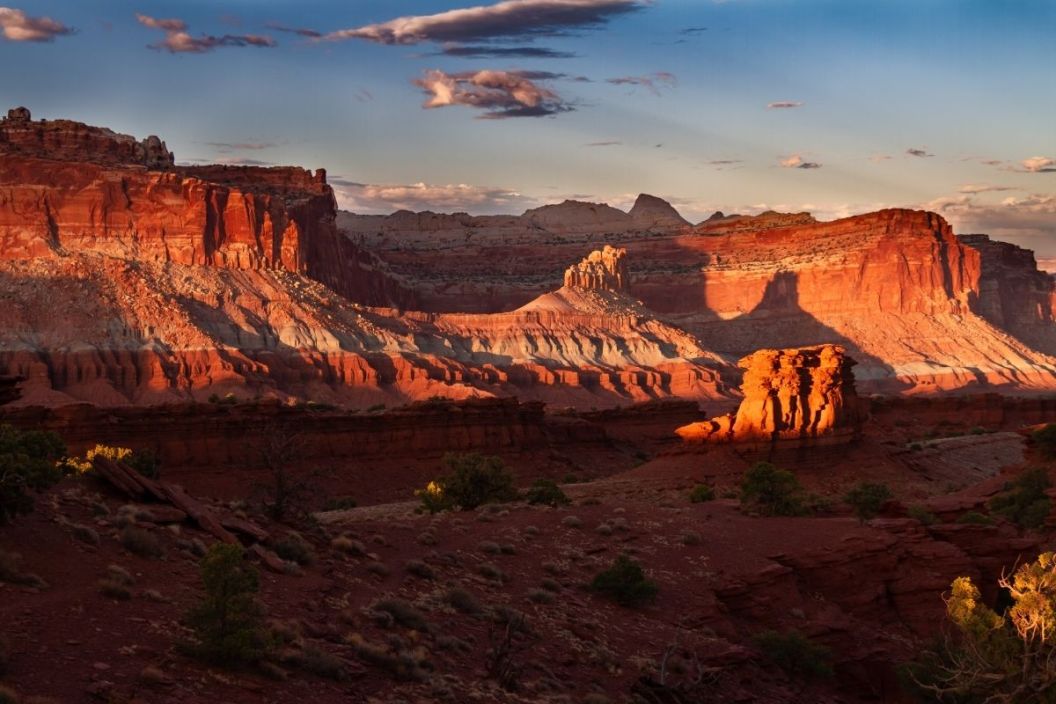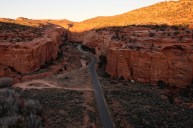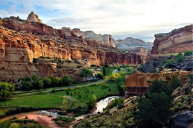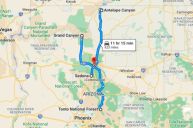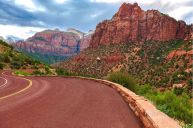When hikers talk about the state of Utah, they probably mention the "Big 5" or the "Mighty 5" — a list that features some of the most popular national parks in the U.S. Most people have heard of Zion National Park and Bryce Canyon National Park, and as you dive more into all that Utah has to offer, you discover Arches National Park and Canyonlands National Park. But the gorgeous Capitol Reef National Park is the most underrated one of this exclusive group, and it shouldn't be overlooked as often as it is.
Located in the city of Torrey near central Utah, north of the Grand Staircase-Escalante National Monument, Capitol Reef National Park is worth seeing just as much as any of its other siblings. From enjoying the glorious red rocks and Navajo Sandstone formations in the daytime to reveling in the star-splattered skies untainted by artificial light at night, here's why this park should be on your bucket list!
History of Capitol Reef National Park
The earliest historical records of Capitol Reef National Park date back 12,000 years ago, after the last Ice Age. It's believed that indigenous Paleo-Indians crossed the Bering Land Bridge to become the very first North Americans. Although not much is known about them, the Archaic Period developed through these early dwellers, who lived as nomadic hunter-gatherers. Fast forward to 2,000 years ago, Fremont and Ancestral Puebloan people (named from the Fremont River that flows through the area) introduced farming into their cultures, growing away from the hunting and gathering period. Petroglyph panels found all over the park paint stories from that time, known as the Common Era, proving that the Fremont culture was quite the thriving civilization.
As more explorers started to survey the area, they discovered incredible geologic formations such as strong rock monoliths in the North District and the magnificent, 100-mile long Waterpocket Fold, a monocline that extends from Thousand Lake Mountain to Lake Powell. Soon, pioneers from the Church of Jesus Christ of Latter-day Saints aimed to organize Mormon missions amongst the indigenous people of the West. And as they moved through the valleys, they established the towns of Clifton, Giles, Elephant, Caineville, Aldridge, Hanksville, and Junction (later renamed as the famous Fruita).
In Fruita, the first orchard trees were planted, and as the town blossomed, the Fruita Schoolhouse was built. A wagon trail was cleared through Capitol Gorge, allowing people to pass through the Waterpocket fold, and the area was later recognized as a state park. By 1937, President Franklin D. Roosevelt set aside 37,711 acres to be known as the Capitol Reef National Monument.
What to Do at Capitol Reef National Park
With all that Capitol Reef National Park has to offer, it's best to have an itinerary handy in order to optimize your visit. With so many options, including road tours, camping, hiking, rock climbing, canyoneering, horseback riding, and more outdoor activities, it's difficult to just randomly pick and choose how you should spend your time.
If you have less than a day to canvas the area, take one of the easier hikes that are less than a mile, such as Capitol Gorge, Goosenecks, Grand Wash, Sunset Point, and Hickman Bridge (an incredible 133-foot natural bridge with breath-taking canyon views). Here is where you can find all the different hiking trails, how long they are, and what difficulty they stand at. You can also tour the Scenic Drive, a 7.9 mile paved road that leads to the Grand Wash and Capitol Gorge. Along the way, you'll see the Moenkopi Rock Formation, the Cassidy Arch, Wingate Sandstone cliffs, and the Navajo Formation— white rounded domes reminiscent of the Capitol Building in Washington, D.C. You'll also have time to check out the area's historical sites, including the Fruita Schoolhouse and the Gifford House Store and Museum, to learn more about the park's significant past.
If you're planning to spend an entire day at Capitol Reef, it's recommended that you take one of the longer hikes, such as Cohab Canyon or Chimney Rock. There are also ranger programs, where you can learn more about the park through ranger guides. One full day is also enough to tour the Cathedral Valley in the North District or the Waterpocket District in the South District.
Cathedral Valley
RELATED: "Georgia's Little Grand Canyon" Leaves Explorers Speechless
If you're looking for a more time-consuming experience, you have several options that include backpacking and camping. You will need a permit for either, so before you head out for an entire weekend, visit here to ensure you have all the necessary permits. This also includes permits to canyon, rock climb, and/or boulder. The Fruita Campground, the only campground within the park, is described as "an oasis within the desert." Reservations are required from March 1 through October 31, and can be made online. Sites have a fire pit and/or above ground grill, but no running water, sewage disposal, or electrical hookups. There are toilets on site, but no showers, and RVs are also allowed.
If you're interested in camping in the remote areas surrounding the park, there are two primitive campgrounds: Cathedral Valley and Cedar Mesa. Cathedral Valley is 36 miles from the visitor center, has no fees (first come, first served basis), and each of the six sites comes with a picnic area and fire grate. Although equipped with pit toilets, there is no water, but the campgrounds are open all year, weather-permitting. Cedar Mesa is also a no fee campground with five sites that have the same amenities as Cathedral Valley. It also serves as the trailhead for the 4.5 mile Red Canyon trail. If these options don't fit your trip or are already filled, you can find plenty of other optional campgrounds to hunker down at!
Capitol Reef: A Dark Sky Park
If you're more into glamping, beautiful surrounding inns and resorts are available to reserve. Check out Capitol Reef Resort or Broken Spur Inn, where you can spend the night in a nice cabin, teepee, or Conestoga wagon. Click here to find more information on other lodgings nearby that you can stay in during your adventure.
Now that you have a basic travel guide of what to possibly do during your visit, there are many more options to check out while exploring the park. Besides the main hiking trails in Fruita, there are also many backcountry hiking trails that might grab your attention, such as Burro Wash and Sulphur Creek Trail. Or take a road tour down Burr Trail Road or Loop the Fold to intake as much of the formations in the park as you can.
And if you thought rocks, cliffs, and canyons were all you could see at the park, don't forget to check out the historic orchards that lie less than a couple of miles near the visitor center. Based on the season, you can pick fresh fruit as told by the signs set in the area. There are also many outdoor activities for the kids, if you're taking the entire family.
How to Visit Capitol Reef National Park
Located at 52 West Headquarters Drive, Capitol Reef National Park is a three and a half hour drive from Salt Lake City. The park is open 24 hours a day, seven days a week, even on holidays. The visitor center, which you might want to stop by before you start your journey, is open every day from 8:00am-4:30pm, with special hours for holidays. Entrance fees are paid at the beginning of Scenic Drive, charging $20 for a private vehicle, $15 for a motorcycle, and $10 for bikers and hikers.
Although the visitor center has public WiFi, there is very little reception in the park. Pets are allowed in developed areas of the park, as long as they are leashed, and service animals are allowed anywhere in the park. You can find more information on the National Park Service website at https://www.nps.gov/care/index.htm.
Have you explored all the underrated Capitol Reef National Park has to offer? Share your adventure at our Wide Open Roads Facebook!
